I'm writing a lighting system for 2D games using a rather common method of 2D radiosity. The idea is to generate a JFA voronoi of the game scene (black, alpha = 1.0 for occluders and color, alpha = 1.0 for emitters) and generate an SDF from the JFA. Next you raymarch every pixel on screen for N rays with M max steps on the SDF with random angle offsets for each pixel. You then sample the emitter/occluder surface at the end point of each ray, step back into empty space and sample again for light emitted in the nearest empty space. This gives you a nice result as seen below:

That isn't the problem, it works great. The problem is efficiency. The idea behind fixing this is to render the GI at 1/N sample size (width/N, height/N) and then upscale the GI using interpolation. As I've done below:

This is the problem. The upscaling I've accomplished using weighted color-interpolation, but it produces these nasty results near occluders:

Here's the full shader:
The uniforms passed are the GI downsampled texture (in_GIField), Scene (emitters/occluders only) Texture (gm_basetexture), Signed Distance Field (in_SDField), Resolution (in_Screen) and the Downsample ratio (in_Sample).
/*
UPSCALING SHADER:
Find the nearest 4 boundign samples to the current pixel (xyDelta & xyShift)
Calculate all of the sample's weights based on whether they're marchable or source pixels.
Final perform a composite weighted interpolation for the current pixel to the nearest 4 samples.
*/
varying vec2 in_Coord;
uniform float in_Sample;
uniform vec2 in_Screen;
uniform sampler2D in_GIField;
uniform sampler2D in_SDField;
#define TPI 9.4247779607693797153879301498385
#define PI 3.1415926535897932384626433832795
#define TAU 6.2831853071795864769252867665590
#define EPSILON 0.001 // floating point precision check
#define dot(f) dot(f,f) // shorthand dot of a single float
float ATAN2(float yy, float xx) { return mod(atan(yy, xx), TAU); }
float DIRECT(vec2 v1, vec2 v2) { vec2 v3 = v2 - v1; return ATAN2(-v3.y, v3.x); }
float DIFFERENCE(float src, float dst) { return mod(dst - src + TPI, TAU) - PI; }
float V2_F16(vec2 v) { return v.x + (v.y / 255.0); }
float VMAX(vec3 v) { return max(v.r, max(v.g, v.b)); }
vec2 SAMPLEXY(vec2 xycoord) { return (floor(xycoord / in_Sample) * in_Sample) + (in_Sample*0.5); }
vec3 TONEMAP(vec3 color, float dist) { return color * (1.0 / (1.0 + dot(dist / min(in_Screen.x, in_Screen.y)))); }
float TESTMARCH(vec2 pix, vec2 end) {
float aspect = in_Screen.x / in_Screen.y,
dst = distance(pix, end);
vec2 dir = normalize((end*in_Screen) - (pix*in_Screen)) / in_Screen;
for(float i = 0.0; i < in_Sample; i += 1.0) {
vec2 test = vec2(pix.x * aspect, pix.y) + (dir * (i/in_Screen));
test.x /= aspect;
vec4 sourceCol = texture2D(gm_BaseTexture, test);
float source = max(sourceCol.r, max(sourceCol.g, sourceCol.b));
if (source < EPSILON && sourceCol.a > 0.0) return 0.0;
}
return 1.0;
}
vec3 WCOMPOSITE(vec3 colors[4], float weights[4], vec2 uv) {
// (uv * A * B) + (B * (1.0 - A)) //0, 2, 1, 3
float weightA = (uv.y * weights[0] * weights[2]) + (weights[2] * (1.0 - weights[0])),
weightB = (uv.y * weights[1] * weights[3]) + (weights[3] * (1.0 - weights[1]));
vec3 colorA = mix(colors[0], colors[2], weightA),
colorB = mix(colors[1], colors[3], weightB);
return mix(colorA, colorB, uv.x);
}
void main() {
vec2 xyCoord = in_Coord * in_Screen;
vec2 xyLight = SAMPLEXY(xyCoord);
vec2 xyDelta = sign(sign(xyCoord - xyLight) - 1.0);
vec2 xyShift[4];
xyShift[0] = vec2(0.,0.) + xyDelta;
xyShift[1] = vec2(1.,0.) + xyDelta;
xyShift[2] = vec2(0.,1.) + xyDelta;
xyShift[3] = vec2(1.,1.) + xyDelta;
vec2 xyField[4]; vec3 xyColor[4]; float notSource[4]; float xyWghts[4];
for(int i = 0; i < 4; i++) {
xyField[i] = (xyLight + (xyShift[i] * in_Sample)) * (1.0/in_Screen);
xyColor[i] = texture2D(in_GIField, xyField[i]).rgb;
notSource[i] = 1.0 - sign(texture2D(gm_BaseTexture, xyField[i]).a);
xyWghts[i] = TESTMARCH(in_Coord, xyField[i]) * sign(VMAX(xyColor[i])) * notSource[i];
}
vec2 uvCoord = mod(xyCoord-xyLight, in_Sample) * (1.0/in_Sample);
vec3 xyFinal = WCOMPOSITE(xyColor, xyWghts, uvCoord);
vec4 xySource = texture2D(gm_BaseTexture, in_Coord);
float isSource = sign(xySource.a);
gl_FragColor = vec4((isSource * xySource.rgb) + ((1.0-isSource) * xyFinal), 1.0);
}
EDIT: This DOES produce the intended result in empty space, but ends up with nasty artifacting near emitters and occluders. I tried to solve this in the for-loop in the main function by weighting out the emitter/occluder (source pixels in the scene texture) colors, but this isn't working.
See shader code attached (Shadertoy). I noticed that the weighting function will actually produce some colors with a weight of 0 (as expected as originally written). I currently don't have a solution for how to remove colors from the interpolation process entirely.